Multifunctional Carbon Nanotubes-Reinforced Surlyn Nanocomposites: A Study of Strain-Sensing and Self-Healing Capabilities
Abstract
:1. Introduction
2. Materials and Methods
2.1. Materials
2.2. Manufacturing of CNT-Reinforced Surlyn Nanocomposites
2.3. Nanocomposite Characterization
2.3.1. Microstructural Characterization
2.3.2. Electrical Conductivity Characterization
2.3.3. Electromechanical Tests
2.3.4. Self-Healing Tests
3. Results and Discussion
3.1. Electrical Conductivity Measurements
3.2. Electromechanical Tests
3.3. Self-Healing Test
3.4. Analysis of Optimum Conditions for Application
4. Conclusions
Author Contributions
Funding
Institutional Review Board Statement
Informed Consent Statement
Data Availability Statement
Conflicts of Interest
References
- Sánchez-Romate, X.F.; Moriche, R.; Jiménez-Suárez, A.; Sánchez, M.; Prolongo, S.G.; Güemes, A.; Ureña, A. Highly Sensitive Strain Gauges with Carbon Nanotubes: From Bulk Nanocomposites to Multifunctional Coatings for Damage Sensing. Appl. Surf. Sci. 2017, 424, 213–221. [Google Scholar] [CrossRef]
- Sánchez, M.; Campo, M.; Jiménez-Suárez, A.; Ureña, A. Effect of the Carbon Nanotube Functionalization on Flexural Properties of Multiscale Carbon Fiber/Epoxy Composites Manufactured by VARIM. Compos. Part B Eng. 2013, 45, 1613–1619. [Google Scholar] [CrossRef]
- Del Bosque, A.; Muñoz, B.K.; Sánchez, M.; Ureña, A. Thermomechanically Robust Ceramic/Polymer Nanocomposites Modified with Ionic Liquid for Hybrid Polymer Electrolyte Applications. ACS Appl. Energy Mater. 2022, 5, 4247–4258. [Google Scholar] [CrossRef]
- Muñoz, B.K.; del Bosque, A.; Sánchez, M.; Utrilla, V.; Prolongo, S.G.; Prolongo, M.G.; Ureña, A. Epoxy Resin Systems Modified with Ionic Liquids and Ceramic Nanoparticles as Structural Composites for Multifunctional Applications. Polymer 2021, 214, 123233. [Google Scholar] [CrossRef]
- Asp, L.E.; Greenhalgh, E.S. Structural Power Composites. Compos. Sci. Technol. 2014, 101, 41–61. [Google Scholar] [CrossRef]
- Terryn, S.; Langenbach, J.; Roels, E.; Brancart, J.; Bakkali-Hassani, C.; Poutrel, Q.A.; Georgopoulou, A.; George Thuruthel, T.; Safaei, A.; Ferrentino, P.; et al. A Review on Self-Healing Polymers for Soft Robotics. Mater. Today 2021, 47, 187–205. [Google Scholar] [CrossRef]
- Guadagno, L.; Naddeo, C.; Raimondo, M.; Barra, G.; Vertuccio, L.; Sorrentino, A.; Binder, W.H.; Kadlec, M. Development of Self-Healing Multifunctional Materials. Compos. Part B Eng. 2017, 128, 30–38. [Google Scholar] [CrossRef]
- Sánchez-Romate, X.F.; García, C.; Rams, J.; Sánchez, M.; Ureña, A. Structural Health Monitoring of a CFRP Structural Bonded Repair by Using a Carbon Nanotube Modified Adhesive Film. Compos. Struct. 2021, 270, 114091. [Google Scholar] [CrossRef]
- Tuloup, C.; Harizi, W.; Aboura, Z.; Meyer, Y.; Khellil, K.; Lachat, R. On the Use of In-Situ Piezoelectric Sensors for the Manufacturing and Structural Health Monitoring of Polymer-Matrix Composites: A Literature Review. Compos. Struct. 2019, 215, 127–149. [Google Scholar] [CrossRef]
- Ahmed, O.; Wang, X.; Tran, M.V.; Ismadi, M.Z. Advancements in Fiber-Reinforced Polymer Composite Materials Damage Detection Methods: Towards Achieving Energy-Efficient SHM Systems. Compos. Part B Eng. 2021, 223, 109136. [Google Scholar] [CrossRef]
- Niendorf, K.; Raeymaekers, B. Combining Ultrasound Directed Self-Assembly and Stereolithography to Fabricate Engineered Polymer Matrix Composite Materials with Anisotropic Electrical Conductivity. Compos. Part B Eng. 2021, 223, 109096. [Google Scholar] [CrossRef]
- Kang, K.C.; Kim, Y.H.; Pyun, J.Y.; Park, K.K. Feasibility Study on Multi-Touch Ultrasound Large-Panel Touchscreen Using Guided Lamb Waves. Measurement 2022, 190, 110755. [Google Scholar] [CrossRef]
- Han, S.; Meng, Q.; Chand, A.; Wang, S.; Li, X.; Kang, H.; Liu, T. A Comparative Study of Two Graphene Based Elastomeric Composite Sensors. Polym. Test. 2019, 80, 106106. [Google Scholar] [CrossRef]
- Chen, H.; Muthuraman, H.; Stokes, P.; Zou, J.; Liu, X.; Wang, J.; Huo, Q.; Khondaker, S.I.; Zhai, L. Dispersion of Carbon Nanotubes and Polymer Nanocomposite Fabrication Using Trifluoroacetic Acid as a Co-Solvent. Nanotechnology 2007, 18, 415606. [Google Scholar] [CrossRef]
- Sánchez-Romate, X.F.; Jiménez-Suárez, A.; Sánchez, M.; Güemes, A.; Ureña, A. Novel Approach to Percolation Threshold on Electrical Conductivity of Carbon Nanotube Reinforced Nanocomposites. RSC Adv. 2016, 6, 43418–43428. [Google Scholar] [CrossRef]
- Nurazzi, N.M.; Sabaruddin, F.A.; Harussani, M.M.; Kamarudin, S.H.; Rayung, M.; Asyraf, M.R.M.; Aisyah, H.A.; Norrrahim, M.N.F.; Ilyas, R.A.; Abdullah, N.; et al. Mechanical Performance and Applications of CNTs Reinforced Polymer Composites—A Review. Nanomaterials 2021, 11, 2186. [Google Scholar] [CrossRef]
- González, C.; Vilatela, J.J.; Molina-Aldareguía, J.M.; Lopes, C.S.; LLorca, J. Structural Composites for Multifunctional Applications: Current Challenges and Future Trends. Prog. Mater. Sci. 2017, 89, 194–251. [Google Scholar] [CrossRef] [Green Version]
- Moriche, R.; Sánchez, M.; Jiménez-Suárez, A.; Prolongo, S.G.; Ureña, A. Strain Monitoring Mechanisms of Sensors Based on the Addition of Graphene Nanoplatelets into an Epoxy Matrix. Compos. Sci. Technol. 2016, 123, 65–70. [Google Scholar] [CrossRef]
- Prolongo, S.G.; Moriche, R.; Jiménez-Suárez, A.; Sánchez, M.; Ureña, A. Advantages and Disadvantages of the Addition of Graphene Nanoplatelets to Epoxy Resins. Eur. Polym. J. 2014, 61, 206–214. [Google Scholar] [CrossRef]
- Del Bosque, A.; Sánchez-Romate, X.F.; Sánchez, M.; Ureña, A. Ultrasensitive and Highly Stretchable Sensors for Human Motion Monitoring Made of Graphene Reinforced Polydimethylsiloxane: Electromechanical and Complex Impedance Sensing Performance. Carbon N. Y. 2022, 192, 234–248. [Google Scholar] [CrossRef]
- Del Bosque, A.; Sánchez-Romate, X.F.; Sánchez, M.; Ureña, A. Flexible Wearable Sensors Based in Carbon Nanotubes Reinforced Poly(Ethylene Glycol) Diglycidyl Ether (PEGDGE): Analysis of Strain Sensitivity and Proof of Concept. Chemosensors 2021, 9, 158. [Google Scholar] [CrossRef]
- Del Bosque, A.; Sánchez-Romate, X.F.; Sánchez, M.; Ureña, A. Wearable Sensors Based on Graphene Nanoplatelets Reinforced Polydimethylsiloxane for Human Motion Monitoring: Analysis of Crack Propagation and Cycling Load Monitoring. Chemosensors 2022, 10, 75. [Google Scholar] [CrossRef]
- Del Bosque, A.; Sánchez-Romate, X.F.; Sánchez, M.; Ureña, A.; Rey, U.; Carlos, J.; Tulipán, C. Easy-Scalable Flexible Sensors Made of Carbon Nanotube-Doped Polydimethylsiloxane: Analysis of Manufacturing Conditions and Proof of Concept. Sensors 2022, 22, 5147. [Google Scholar] [CrossRef]
- Wang, C.; Qu, X.; Zheng, Q.; Liu, Y.; Tan, P.; Shi, B.; Ouyang, H.; Chao, S.; Zou, Y.; Zhao, C.; et al. Stretchable, Self-Healing, and Skin-Mounted Active Sensor for Multipoint Muscle Function Assessment. ACS Nano 2021, 15, 10130–10140. [Google Scholar] [CrossRef] [PubMed]
- Xu, L.; Chen, Y.; Guo, Z.; Tang, Z.; Luo, Y.; Xie, S.; Li, N.; Xu, J. Flexible Li+/Agar/PHEAA Double-Network Conductive Hydrogels with Self-Adhesive and Self-Repairing Properties as Strain Sensors for Human Motion Monitoring. React. Funct. Polym. 2021, 168, 105054. [Google Scholar] [CrossRef]
- Yang, T.; Xiang, H.; Qin, C.; Liu, Y.; Zhao, X.; Liu, H.; Li, H.; Ouzounian, M.; Hong, G.; Chen, H.; et al. Highly Sensitive 1T-MoS2 Pressure Sensor with Wide Linearity Based on Hierarchical Microstructures of Leaf Vein as Spacer. Adv. Electron. Mater. 2020, 6, 1900916. [Google Scholar] [CrossRef]
- Wang, R.; Liu, Z.; Wan, G.; Jia, T.; Zhang, C.; Wang, X.; Zhang, M.; Qian, D.; De Andrade, M.J.; Jiang, N.; et al. Controllable Preparation of Ordered and Hierarchically Buckled Structures for Inflatable Tumor Ablation, Volumetric Strain Sensor, and Communication via Inflatable Antenna. ACS Appl. Mater. Interfaces 2019, 11, 10862–10873. [Google Scholar] [CrossRef]
- Varley, R. Ionomers as Self Healing Polymers. In Self Healing Materials; Springer: Berlin/Heidelberg, Germany, 2007; Volume 100, pp. 95–114. [Google Scholar] [CrossRef]
- Mirabedini, S.M.; Alizadegan, F. Ionomers as Self-Healing Materials. In Self-Healing Polymer-Based Systems; Elsevier: Amsterdam, The Netherlands, 2020; pp. 279–291. [Google Scholar] [CrossRef]
- Varley, R.J.; van der Zwaag, S. Towards an Understanding of Thermally Activated Self-Healing of an Ionomer System during Ballistic Penetration. Acta Mater. 2008, 56, 5737–5750. [Google Scholar] [CrossRef]
- Kalista, S.J.; Ward, T.C. Thermal Characteristics of the Self-Healing Response in Poly(Ethylene-Co-Methacrylic Acid) Copolymers. J. R. Soc. Interface 2006, 4, 405–411. [Google Scholar] [CrossRef] [Green Version]
- Calderón-Villajos, R.; López, A.J.; Peponi, L.; Manzano-Santamaría, J.; Ureña, A. 3D-Printed Self-Healing Composite Polymer Reinforced with Carbon Nanotubes. Mater. Lett. 2019, 249, 91–94. [Google Scholar] [CrossRef]
- Sang, Z.; Ke, K.; Manas-Zloczower, I. Effect of Carbon Nanotube Morphology on Properties in Thermoplastic Elastomer Composites for Strain Sensors. Compos. Part A Appl. Sci. Manuf. 2019, 121, 207–212. [Google Scholar] [CrossRef]
- Wang, R.; Kuan, H.C.; Qiu, A.; Su, X.; Ma, J. A Facile Approach to the Scalable Preparation of Thermoplastic/Carbon Nanotube Composites. Nanotechnology 2020, 31, 195706. [Google Scholar] [CrossRef] [PubMed]
- Kasaliwal, G.R.; Pegel, S.; Göldel, A.; Pötschke Petra, P.; Heinrich, G. Analysis of Agglomerate Dispersion Mechanisms of Multiwalled Carbon Nanotubes during Melt Mixing in Polycarbonate. Polymer 2010, 51, 2708–2720. [Google Scholar] [CrossRef]
- Hennrich, F.; Krupke, R.; Arnold, K.; Rojas Stütz, J.A..; Lebedkin, S.; Koch, T.; Schimmel, T.; Kappes, M.M. The Mechanism of Cavitation-Induced Scission of Single-Walled Carbon Nanotubes. J. Phys. Chem. B 2007, 111, 1932–1937. [Google Scholar] [CrossRef]
- Simmons, J.G. Generalized Formula for the Electric Tunnel Effect between Similar Electrodes Separated by a Thin Insulating Film. J. Appl. Phys. 2004, 34, 1793. [Google Scholar] [CrossRef] [Green Version]
- Sánchez-Romate, X.F.; Artigas, J.; Jiménez-Suárez, A.; Sánchez, M.; Güemes, A.; Ureña, A. Critical Parameters of Carbon Nanotube Reinforced Composites for Structural Health Monitoring Applications: Empirical Results versus Theoretical Predictions. Compos. Sci. Technol. 2019, 171, 44–53. [Google Scholar] [CrossRef]
- Hu, N.; Karube, Y.; Arai, M.; Watanabe, T.; Yan, C.; Li, Y.; Liu, Y.; Fukunaga, H. Investigation on Sensitivity of a Polymer/Carbon Nanotube Composite Strain Sensor. Carbon N. Y. 2010, 48, 680–687. [Google Scholar] [CrossRef]
- Li, S.; Li, R.; González, O.G.; Chen, T.; Xiao, X. Highly Sensitive and Flexible Piezoresistive Sensor Based on C-MWCNTs Decorated TPU Electrospun Fibrous Network for Human Motion Detection. Compos. Sci. Technol. 2021, 203, 108617. [Google Scholar] [CrossRef]
- Nurazzi, N.M.; Asyraf, M.R.M.; Khalina, A.; Abdullah, N.; Sabaruddin, F.A.; Kamarudin, S.H.; Ahmad, S.; Mahat, A.M.; Lee, C.L.; Aisyah, H.A.; et al. Fabrication, Functionalization, and Application of Carbon Nanotube-Reinforced Polymer Composite: An Overview. Polymers 2021, 13, 1047. [Google Scholar] [CrossRef]
- Imtiaz, S.; Siddiq, M.; Kausar, A.; Muntha, S.T.; Ambreen, J.; Bibi, I. A Review Featuring Fabrication, Properties and Applications of Carbon Nanotubes (CNTs) Reinforced Polymer and Epoxy Nanocomposites. Chinese J. Polym. Sci. 2017, 36, 445–461. [Google Scholar] [CrossRef]
- Nasiri, A.; Shariaty-Niasar, M.; Rashidi, A.M.; Khodafarin, R. Effect of CNT Structures on Thermal Conductivity and Stability of Nanofluid. Int. J. Heat Mass Transf. 2012, 55, 1529–1535. [Google Scholar] [CrossRef]
- Behdinan, K.; Moradi-Dastjerdi, R.; Safaei, B.; Qin, Z.; Chu, F.; Hui, D. Graphene and CNT Impact on Heat Transfer Response of Nanocomposite Cylinders. Nanotechnol. Rev. 2020, 9, 41–52. [Google Scholar] [CrossRef] [Green Version]
- Sánchez-Romate, X.F.; Sans, A.; Jiménez-Suárez, A.; Campo, M.; Ureña, A.; Prolongo, S.G. Highly Multifunctional GNP/Epoxy Nanocomposites: From Strain-Sensing to Joule Heating Applications. Nanomaterials 2020, 10, 2431. [Google Scholar] [CrossRef] [PubMed]
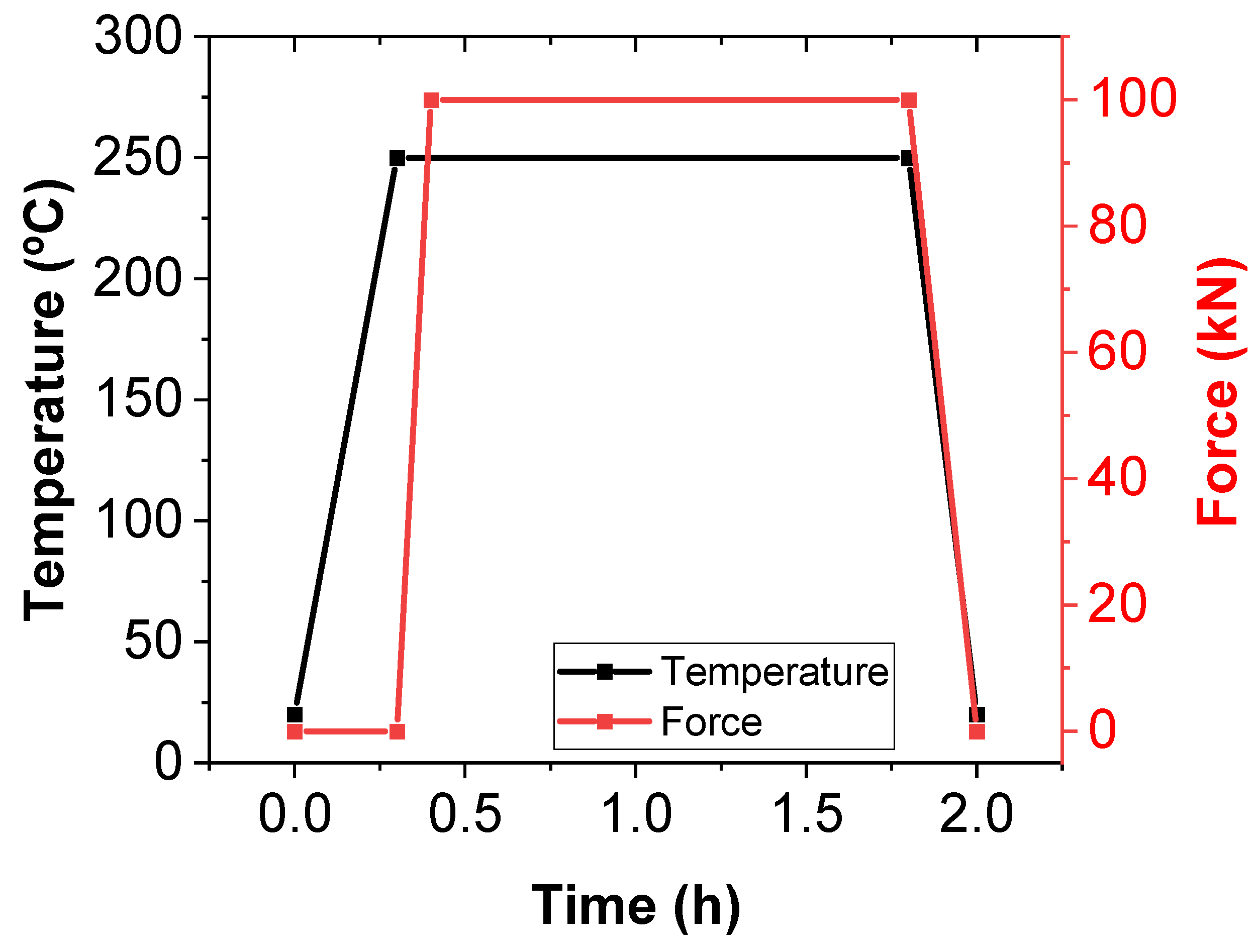

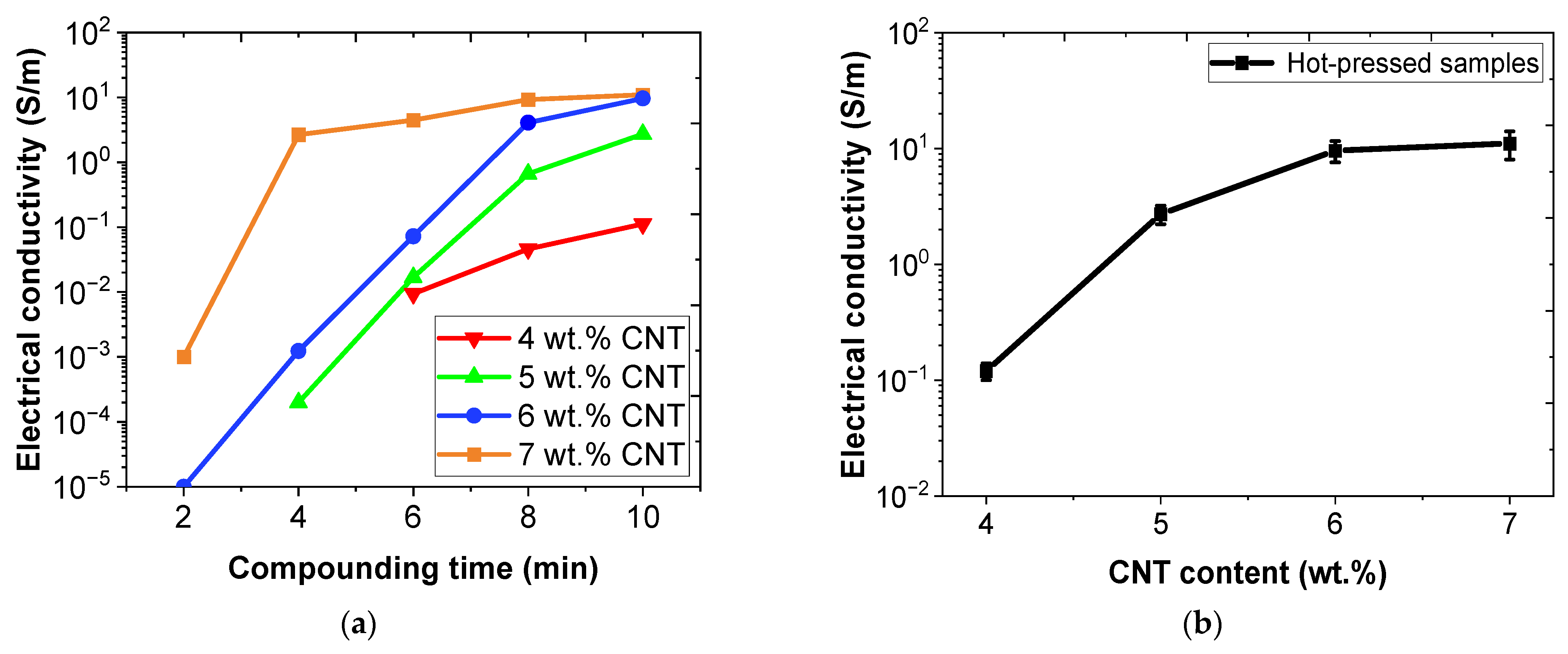
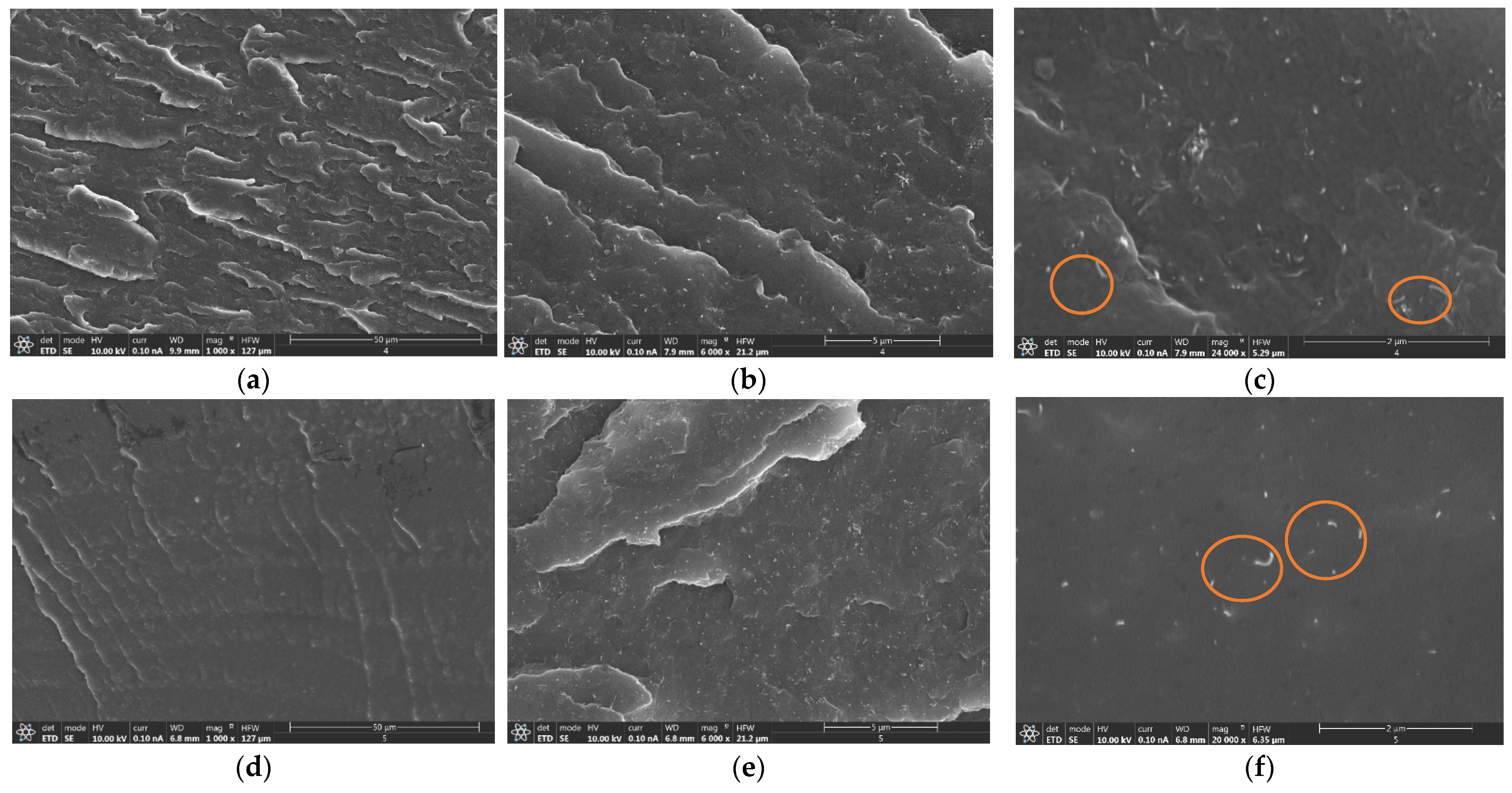
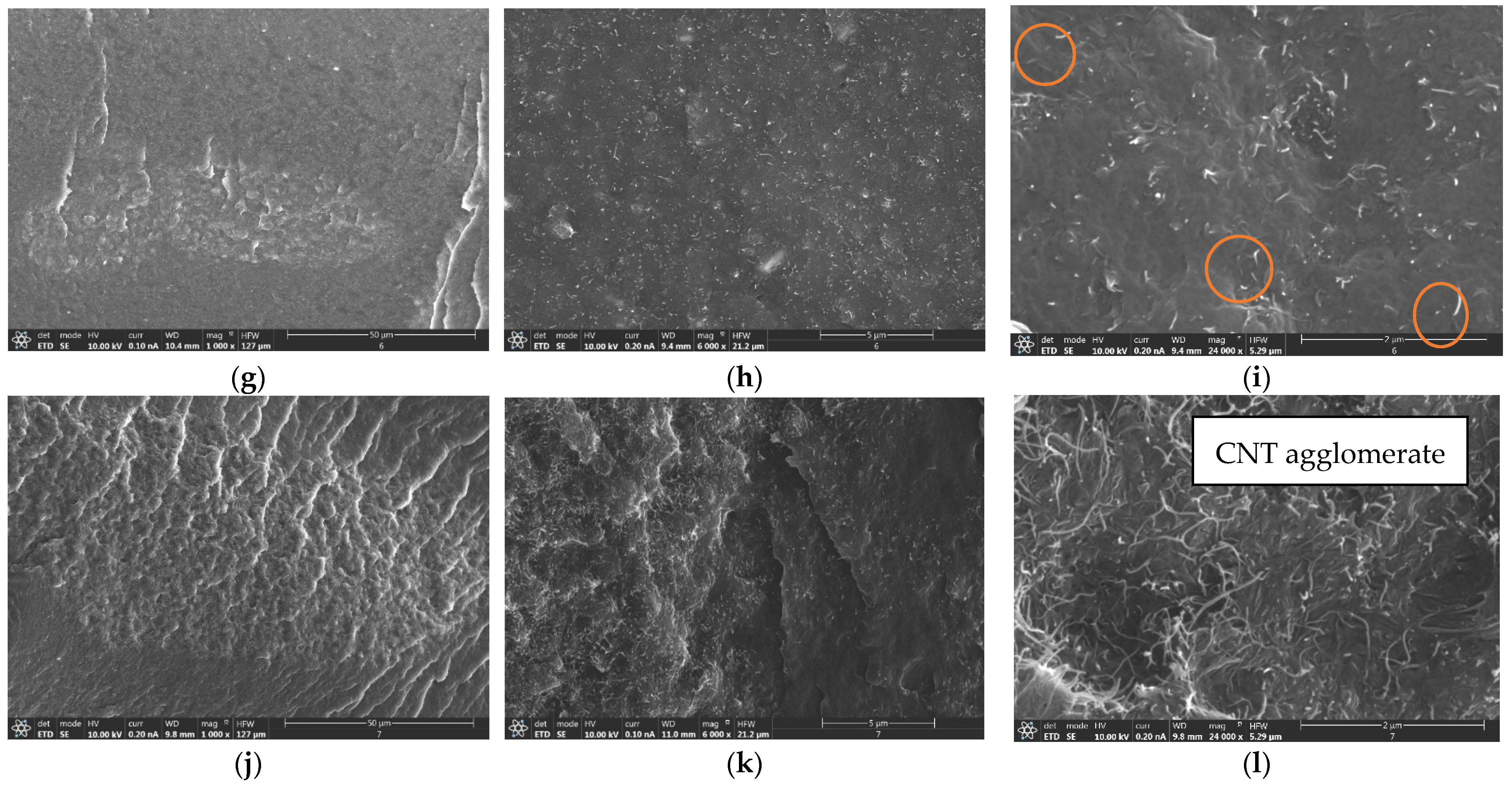
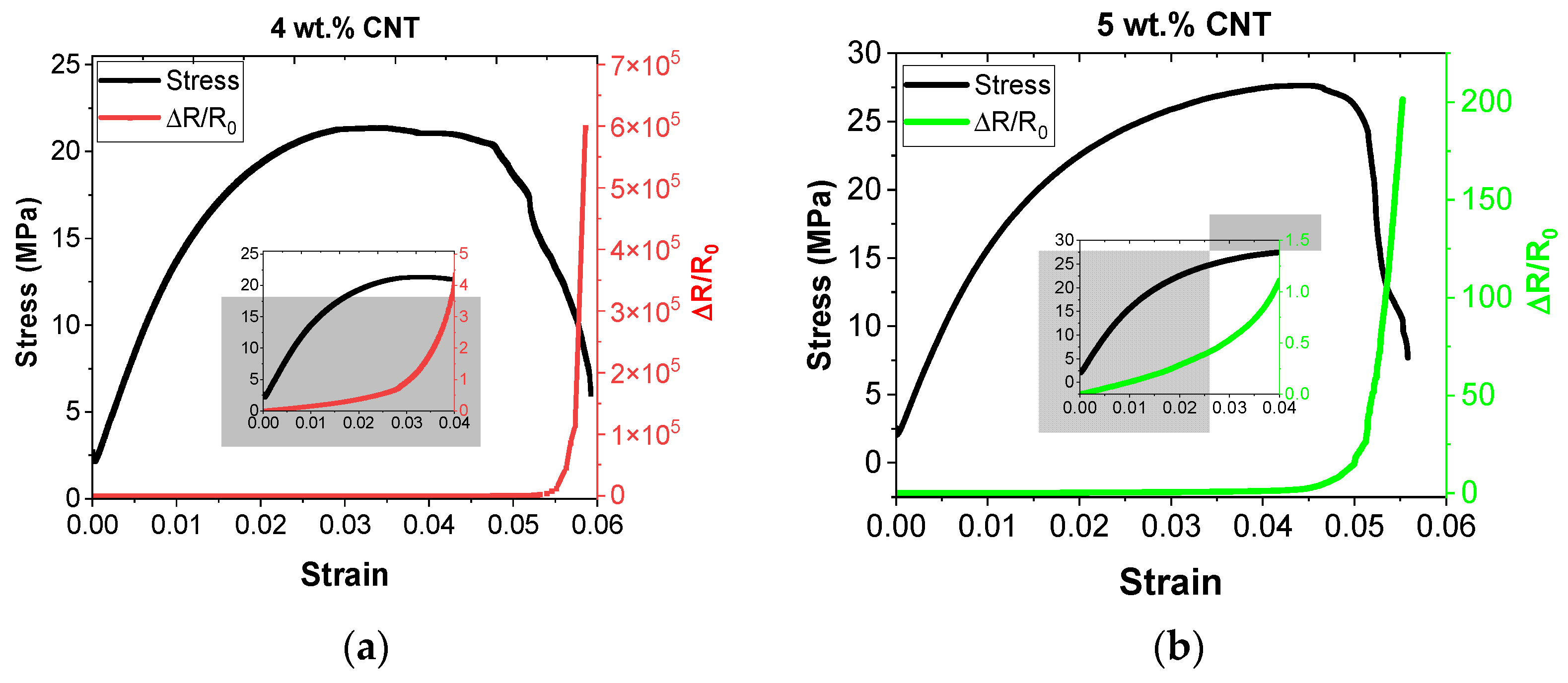

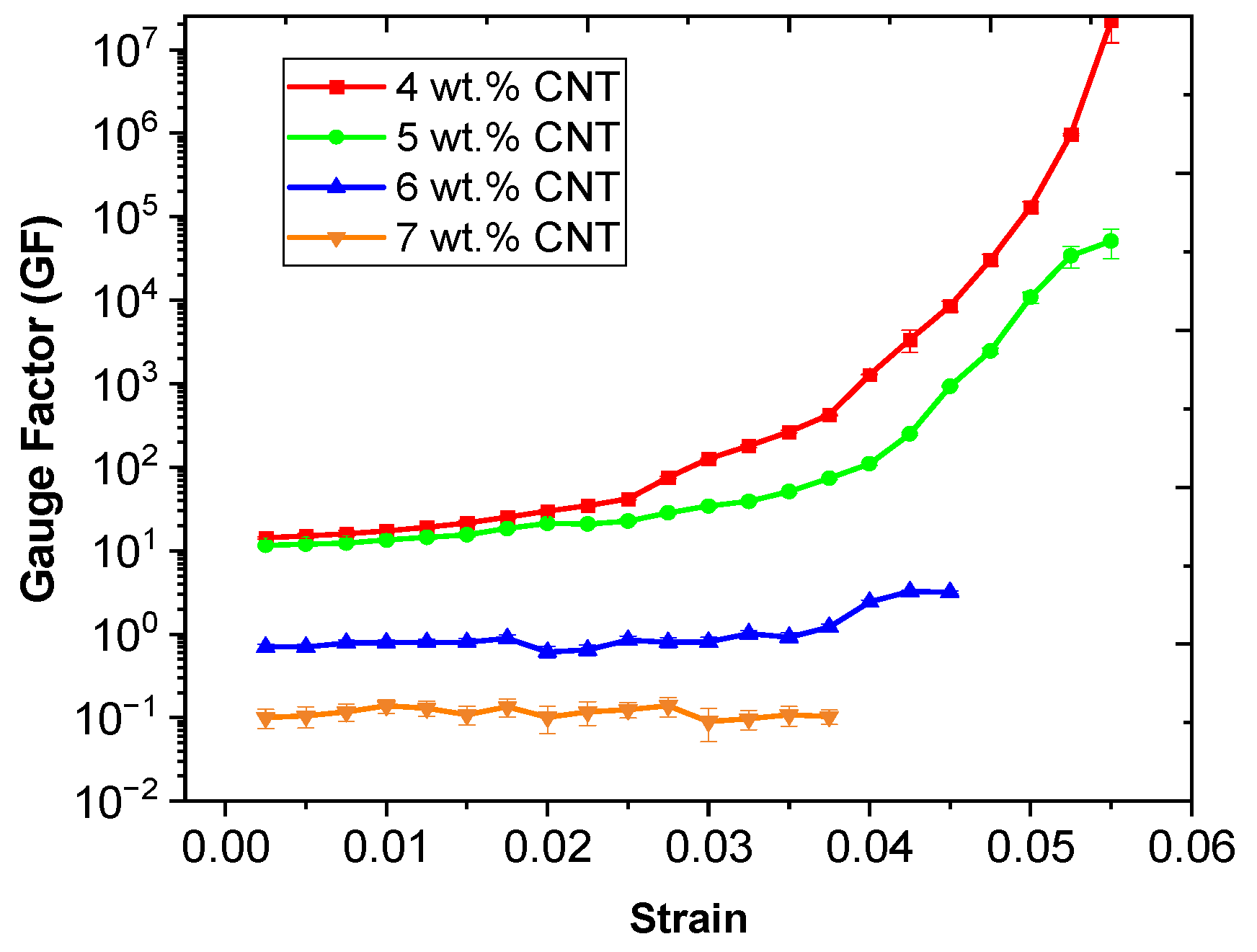

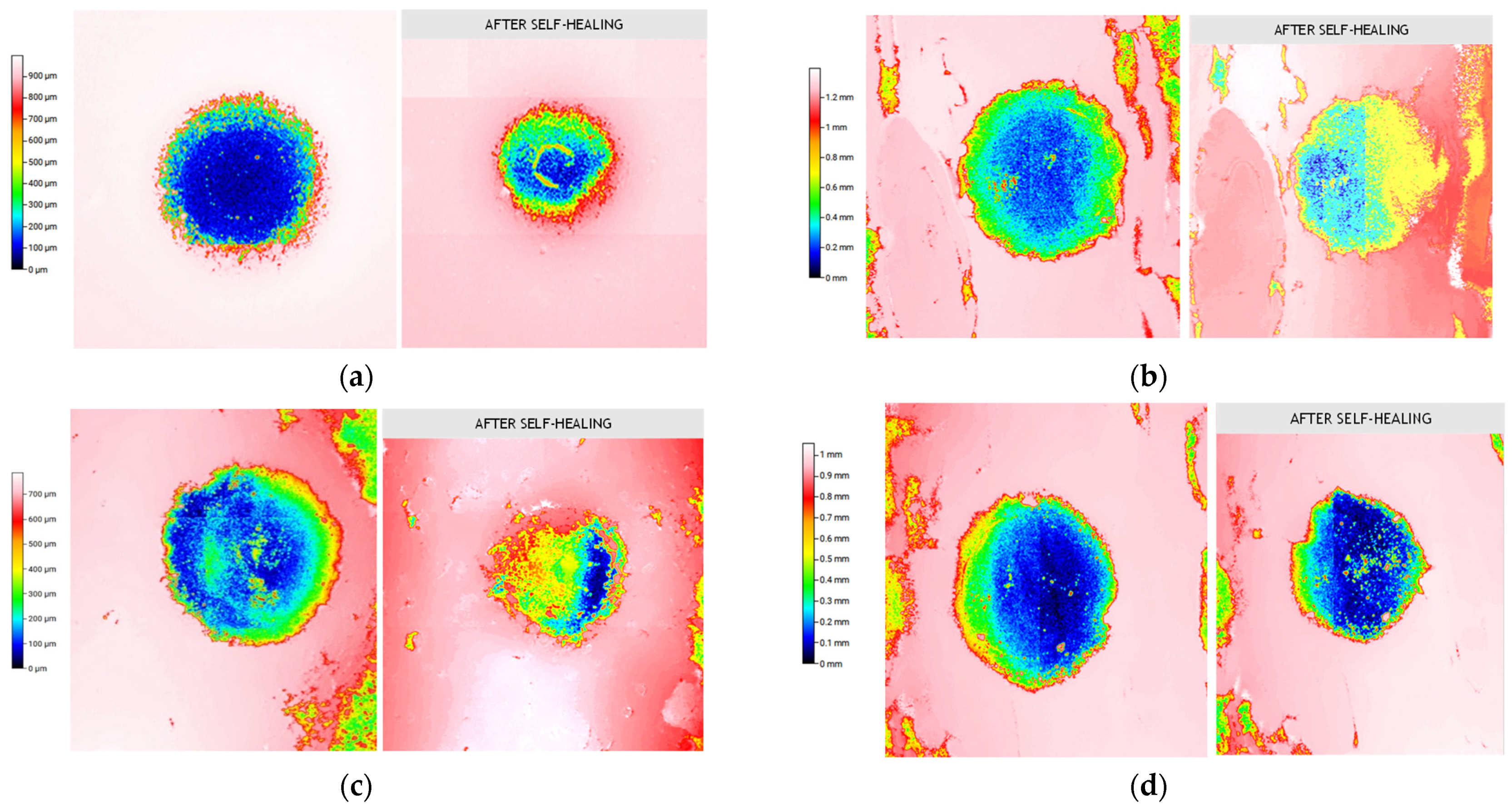
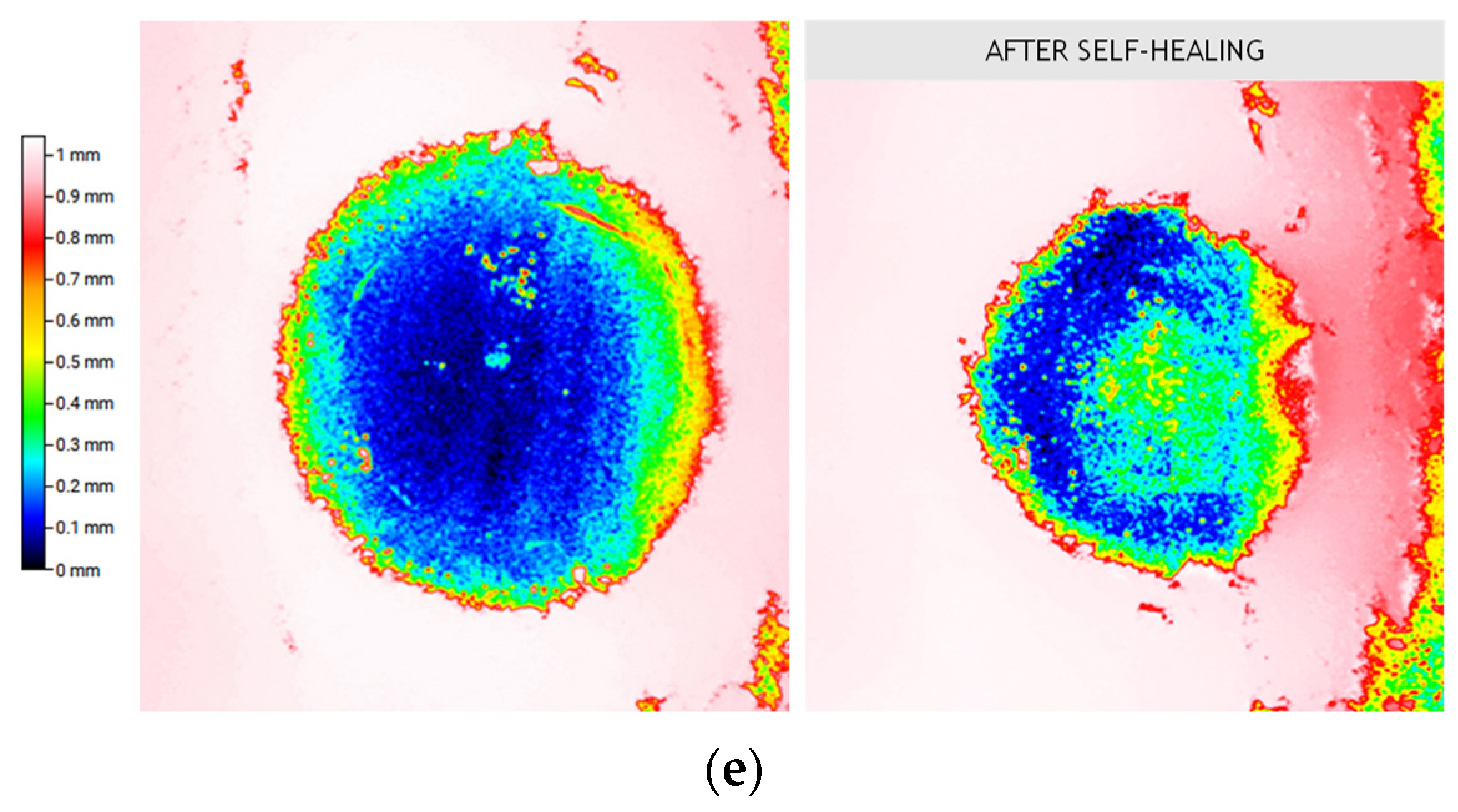
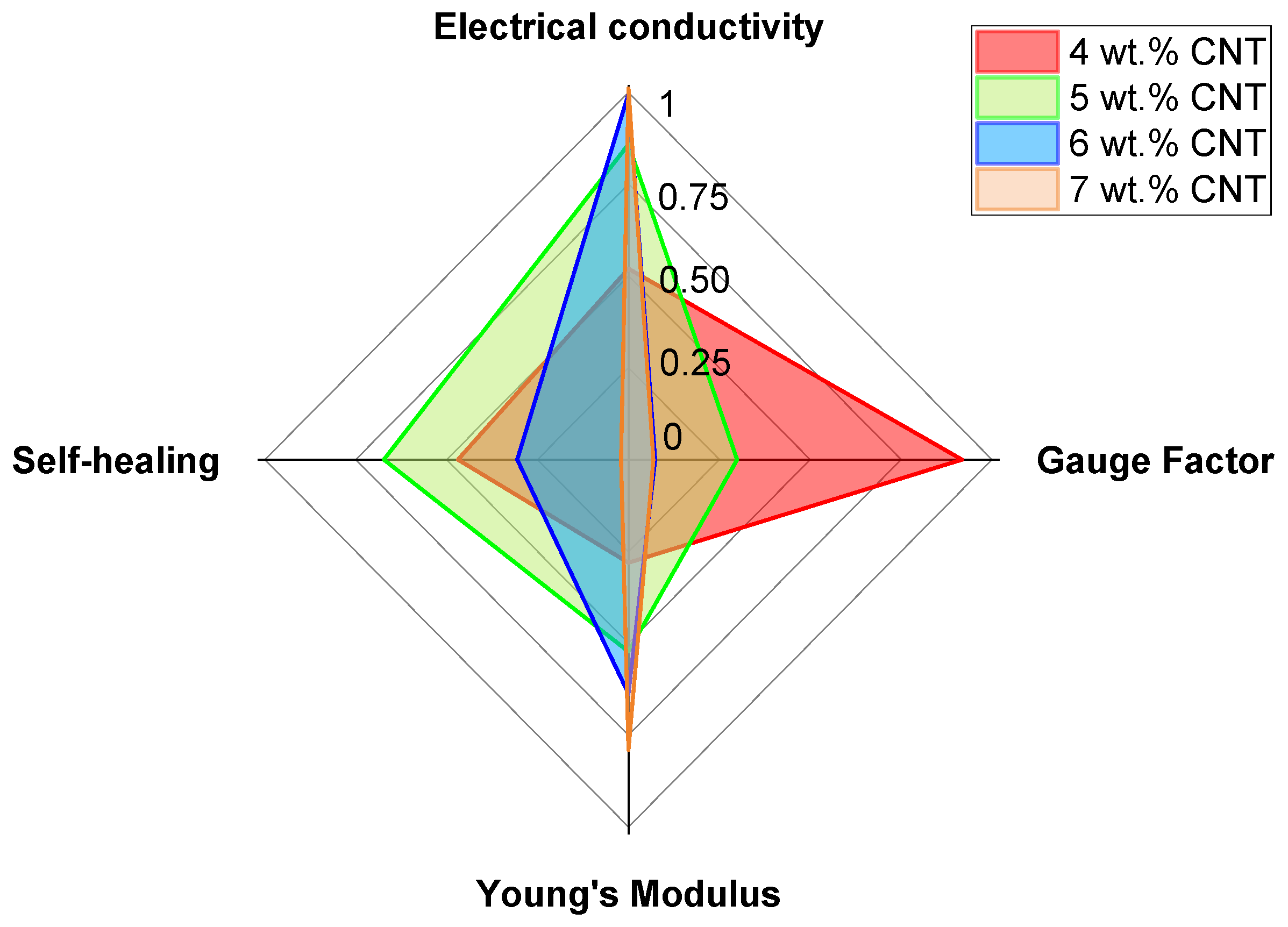
| Neat | 4 wt.% CNT | 5 wt.% CNT | 6 wt.% CNT | 7 wt.% CNT | |
|---|---|---|---|---|---|
| E (GPa) | 1.12 ± 0.07 | 1.22 ± 0.14 | 1.41 ± 0.16 | 1.50 ± 0.09 | 1.62 ± 0.20 |
| σTS (MPa) | 23.05 ± 2.70 | 21.37 ± 3.55 | 27.64 ± 4.45 | 28.09 ± 3.12 | 28.35 ± 4.98 |
| Ɛf | 0.061 ± 0.005 | 0.059 ± 0.003 | 0.056 ± 0.007 | 0.058 ± 0.010 | 0.035 ± 0.009 |
| V (%) | 66 ± 2 | 73 ± 5 | 83 ± 2 | 65 ± 5 | 51 ± 11 |
Publisher’s Note: MDPI stays neutral with regard to jurisdictional claims in published maps and institutional affiliations. |
© 2022 by the authors. Licensee MDPI, Basel, Switzerland. This article is an open access article distributed under the terms and conditions of the Creative Commons Attribution (CC BY) license (https://creativecommons.org/licenses/by/4.0/).
Share and Cite
del Bosque, A.; Calderón-Villajos, R.; Sánchez, M.; Ureña, A. Multifunctional Carbon Nanotubes-Reinforced Surlyn Nanocomposites: A Study of Strain-Sensing and Self-Healing Capabilities. Nanomaterials 2022, 12, 2878. https://doi.org/10.3390/nano12162878
del Bosque A, Calderón-Villajos R, Sánchez M, Ureña A. Multifunctional Carbon Nanotubes-Reinforced Surlyn Nanocomposites: A Study of Strain-Sensing and Self-Healing Capabilities. Nanomaterials. 2022; 12(16):2878. https://doi.org/10.3390/nano12162878
Chicago/Turabian Styledel Bosque, Antonio, Rocío Calderón-Villajos, María Sánchez, and Alejandro Ureña. 2022. "Multifunctional Carbon Nanotubes-Reinforced Surlyn Nanocomposites: A Study of Strain-Sensing and Self-Healing Capabilities" Nanomaterials 12, no. 16: 2878. https://doi.org/10.3390/nano12162878
APA Styledel Bosque, A., Calderón-Villajos, R., Sánchez, M., & Ureña, A. (2022). Multifunctional Carbon Nanotubes-Reinforced Surlyn Nanocomposites: A Study of Strain-Sensing and Self-Healing Capabilities. Nanomaterials, 12(16), 2878. https://doi.org/10.3390/nano12162878









